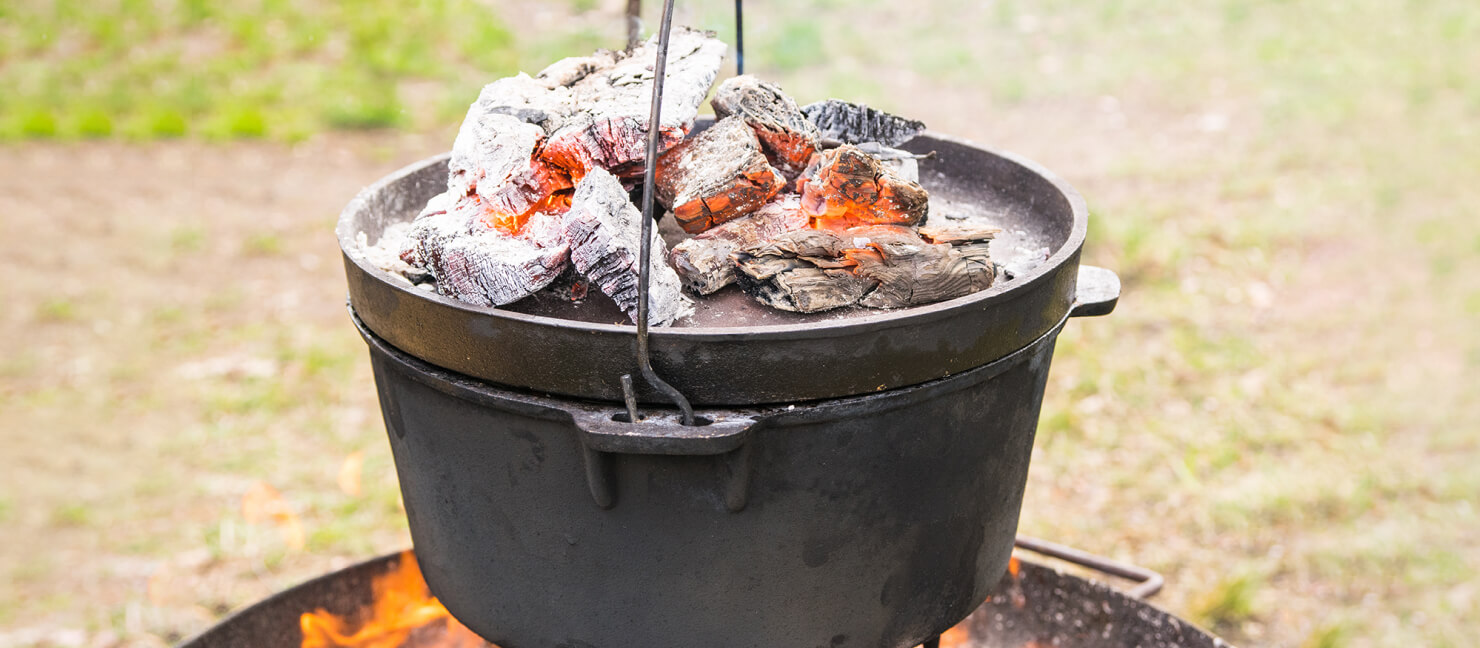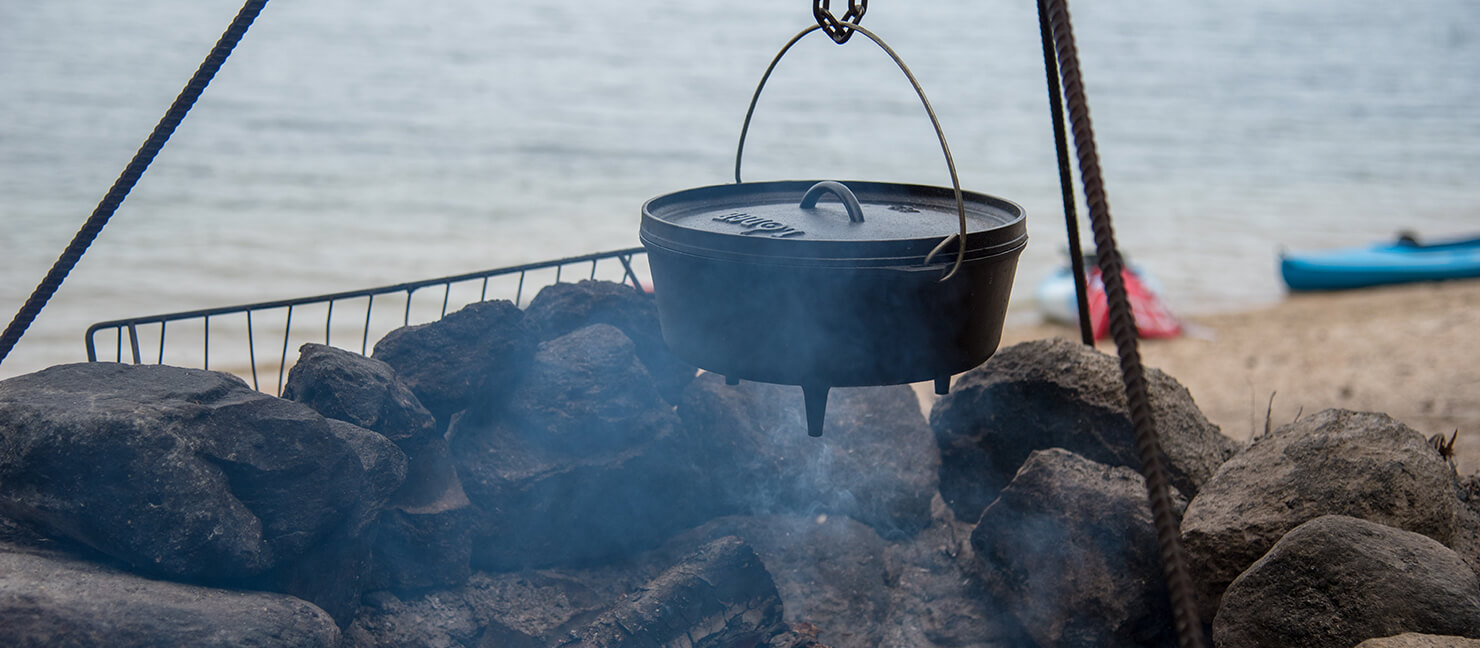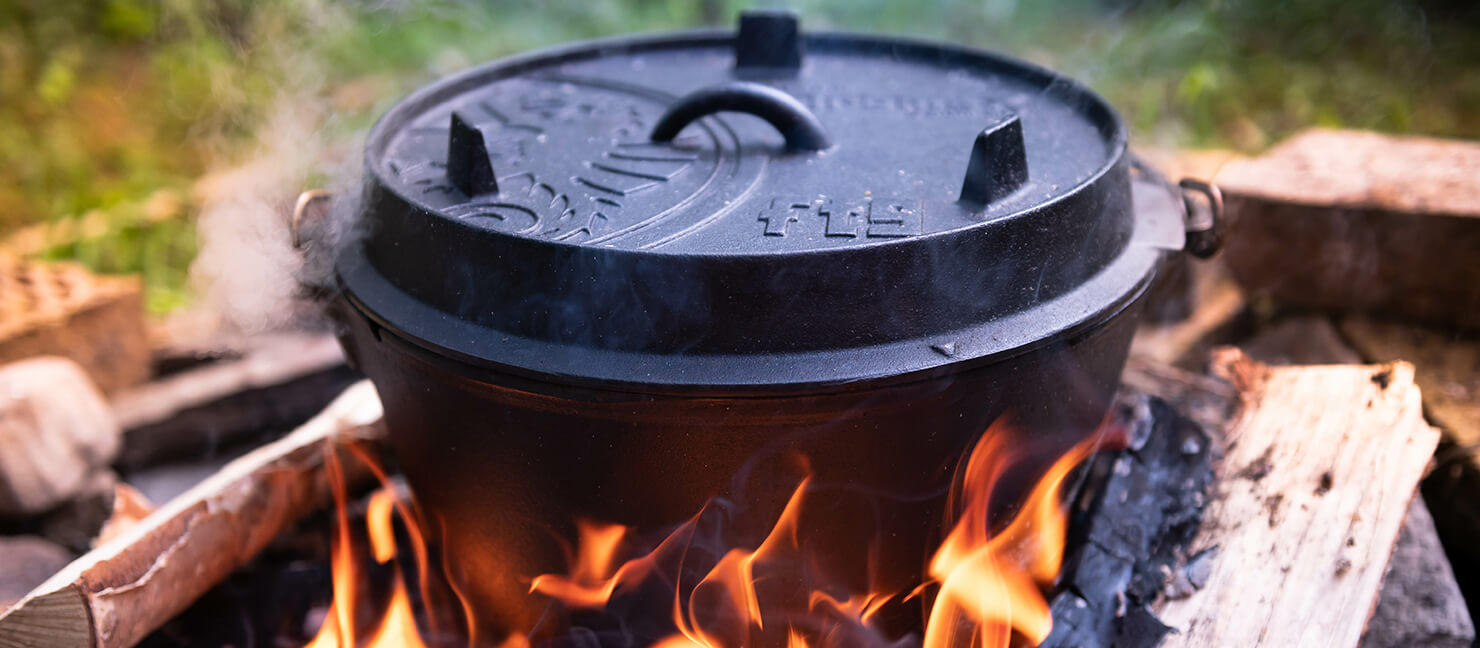Dutch Oven Size Chart: What Size Should You Buy + More

Whether you use it over an open fire or on the stovetop, a Dutch oven can cook just about anything. But they help create a certain atmosphere outdoors around the campsite in a way that stoves just can’t quite match.Characterized by a shallow and wide shape, they feature thick walls usually made of cast iron and a tight-fitting lid. These heavy walls help maintain constant cooking temps, while the tight-fitting lid ensures no heat escapes.
Camping with a Dutch Oven
A Dutch oven is a versatile camping essential that helps you cook everything from breakfast to dessert. The best kind of dutch oven for camping is one specifically listed as a camping Dutch oven since it features:
Support legs to elevate above coals.
A flat, flanged lid with a handle, which allows you to pile coals on the lid for even cooking, and lift it easily in and out of the fire.
A construction made entirely of cast iron, as Dutch ovens intended for home use often have an enamel coating that is not rated for the heat of a campfire.
Expert Tip:
If you want to cook outdoors, we don’t recommend lugging the one you usually cook with at home into the woods.
Considerations for Choosing Your Camping Dutch Oven
When choosing a dutch oven for camping, take into account the pot’s size, weight, material, maintenance, and shape:
Camping Dutch Oven Size Chart
The most important aspect of selecting a Dutch oven for camping is its size. A too-small Dutch oven may not accommodate everyone in your group, while a larger one may be inefficient at cooking and difficult to transport.Remember that cast iron is heavy! Cast iron Dutch ovens can weigh upwards of 30+ pounds. A Dutch oven’s capacity is measured in quarts, and you can think of sizing as 1 quart per person/portion.
| Cast Iron Dutch Oven Size Chart | ||
|---|---|---|
| Dutch Oven Size | Capacity (In Quarts) | People Served* |
| 10-in oven (Shallow) | 4-qt | 2–4 |
| 10-in oven (Deep) | 6-qt | 4–5 |
| 12-in oven (Shallow) | 8-qt | 6–8 |
| 12-in oven (Deep) | 9.3-qt | 8–10 |
| 14-in oven (Shallow) | 8-qt | 6–8 |
| 14-in oven (Deep) | 12-qt | 10–12 |
| 16-in oven (Shallow) | 10-qt | 8–10 |
*People served is based on the ~1 qt per person rule of thumb.
Dutch Oven Diameter and Depth
Other common measurements you’ll see when shopping for a Dutch oven is diameter and depth:
Diameter is measured in inches from one side of the pot to the other. This is very important if you are preparing very large cuts of meat. If you’re doing so, it may be useful for you to use an oval-shaped Dutch oven, which can also be used to cook anything else a round-shape would.
Standard depths (sometimes called shallow) will more evenly distribute heat because the lid is closer to the bottom. Therefore, these are better suited for casseroles, smaller cuts of meat, and baking rolls, biscuits, and cakes.
Extra depth is useful when cooking soups, stews, chili, and beans and frying so that the liquid doesn’t boil over. Dutch ovens labeled as deep are also great for cooking larger items like loaves of bread, ribs, and lasagna as well as roasting larger/taller cuts of meat (when you’ll need a tight fit on the lid).
Why You Should Always Use Cast Iron Dutch Ovens

Not all cast iron Dutch ovens are made equal! Many intended for indoor use only are coated with a special enamel that usually cannot withstand temperatures higher than 500°F — which is often produced by hot charcoal or the open flame of a campfire.
Dutch ovens made of aluminum or ceramic are also not recommended for camping either for similar reasons. Cast iron Dutch ovens specifically built for camping are durable and can last a lifetime if properly taken care of.
Expert Tip:
When using a dutch oven for camping, always seasoned yours before the first use as well as after each time you cook with it.
Other Considerations
Cast iron Dutch are historically a classic method of cooking food! They’ve been around for centuries and typically don’t have many bells and whistles. However, there are some bonus features that may help you have more success cooking at your campsite:
Hooks and handles: A long, sturdy handle provides an easier cooking experience and helps prevent the pot from dropping into the fire. Hooks are useful for hanging pots by their handles from a tripod. Remember to always use gloves when touching the lid or pot handle of your Dutch oven!
Rimmed lid: Your Dutch oven lid should have a tight-fitting, flat top with a rim. This is so you can pile coal on top to better distribute heat while cooking. You can even use the lid as another cooking vessel on its own if needed. Note that some lids have designs/brand names on them. While this isn’t a deal breaker, they are more difficult to clean and will collect ash.
Versatile lid: Many Dutch ovens come with a lid that can be inverted and used as a griddle, which is useful for searing and grilling. Some even have legs built right into the lid for doing so.
Legs/tripod: Camping Dutch ovens often have three legs on the bottom, which is useful for elevating the pot above hot coals when cooking. If your oven doesn’t have legs, you will need to use a tripod to cook over a fire. (A Dutch oven with legs can be used on a cooking tripod as well.)
Is Camping with a Dutch Oven Worth It?
The short answer is YES! But like with all camping gear and essentials, the long answer also depends on the following:
Where you’re camping
With how many people for whom you’ll need to cook
For how long you’ll stay
Expert Tip:
Camping and cooking with a Dutch oven are really fun, but it’s certainly not for everyone! If you do not enjoy cooking, you likely won’t find this method the best for you while camping.
Achieving a perfectly cooked meal requires quite a bit of time: both in prepping as well as in cooking. Dutch ovens are also heavy, so it is not something you’d want to have to carry a long distance when you have to hike from your car to your campsite. Some other pros and cons of camping with a dutch oven include:
Pros for Camping with a Dutch Oven
Comfort: If you use dutch ovens at home, it makes for a familiar, comfortable cooking experience.
Creativity: You get the benefits of a more creative, flexible, and adaptive experience while cooking your favorite recipes. You can also try recipes and baked goods you wouldn’t have been able to make while camping otherwise.
Options: You’re able to bake and slow-cook meals, opening up what type of meals you’re able to prepare.
One-pot meals: Less camping cookware to clean up.
Relaxing: Cooking with a Dutch oven is a slower process, which can be nice for chilling around the fire.
Cons for Camping with a Dutch Oven
Heavy: Dutch ovens are heavy, and most will take up a bit of room in your car. For that reason, it’s not ideal for backpacking or other on-the-go outdoor activities other than car camping.
Requires campfire/coals: Areas with a burn ban on campfires render dutch ovens useless.
Difficult to control temperature: Temperature control is almost impossible to know, unlike a camping stove.
Requires maintenance: Cleaning and good care can be a hassle when you want to do other things during your trip.
It takes time: If you don’t enjoy sitting around watching a fire while waiting for your food, you may not enjoy cooking with a Dutch oven.
Enhance Your Cooking Experience With These Accessories

While Dutch ovens are ready to provide a great cooking experience right out of the proverbial box, you can further enhance your time cooking with a Dutch oven with these accessories.
Charcoal Starter: A charcoal chimney starter like Oklahoma Joe's Half-Time Charcoal Starter XL will fire up your charcoal without lighter fluid and will have hot coals ready to cook in about 10 minutes.
Lid Lifter: Just like the body of your Dutch oven, the lid handle will get HOT. To remove the lid safely while cooking, you can reach into open flames with a heavy-duty oven mitt or glove to cover your hand, or you can use a lid lifter like this Outdoor Gourmet Lid Lifter.
Tongs: A set of tongs long enough to reach into the fire like the Outdoor Gourmet Deluxe Stainless-Steel Tongs will help protect you from burns while cooking or placing hot coals under or on your Dutch oven.
Tripod: Cooking tripods are often available in different sizes and typically have an S-hook on the chain so you can adjust how high or low your Dutch oven hangs by its handle over the fire. You’ll need a tripod if your Dutch oven doesn’t have feet.
Storage Bag/Tote: A dedicated bag for your Dutch oven makes transporting your vessel from car to campsite a breeze and protects it during your journey and in storage.
Cleaning & Care Tools: Scrapers for your Dutch oven are designed to reach hard-to-get corners and make sure the bottom and sides of your pan are clean as well. Use scrubbers with a delicate touch as they could sabotage the seasoning you’ve worked so hard on or damage the cast iron entirely.
Have Fun Out There!
Ready to make your choice? Shop our selection of cast iron Dutch ovens and accessories for camping online at Academy Sports + Outdoors. Be sure to catch our guide to learn how to use a cast iron dutch oven for camping before you get to your campsite!


